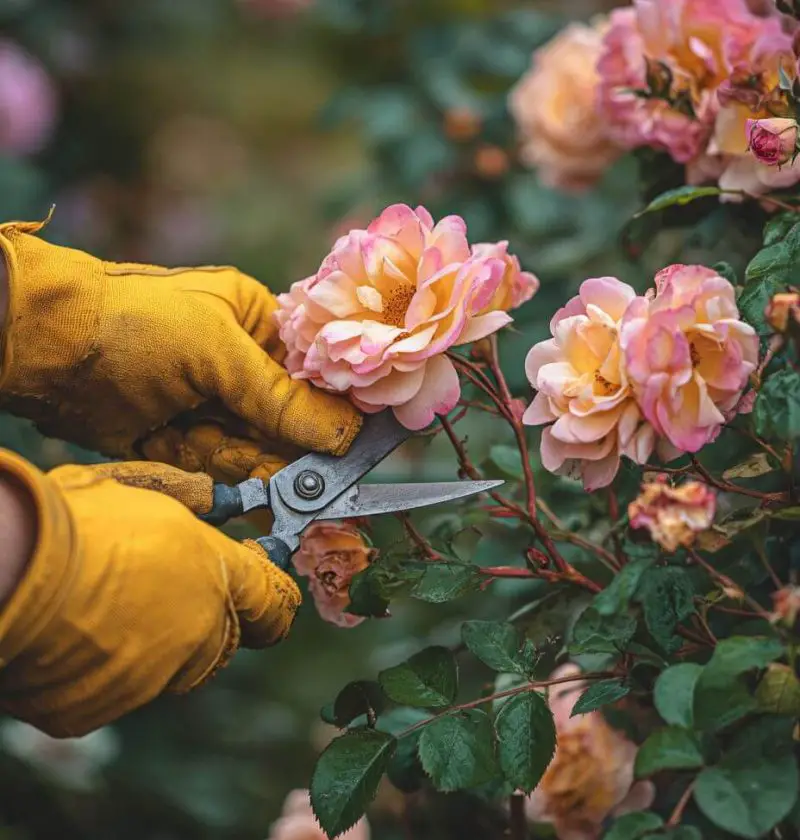I’m gonna tell you something I wish someone had told me years ago:
Your roses aren’t mad at you. They’re just tired.
And the reason? You’re probably not deadheading them. Or maybe you are… but not quite right. And I say that with love, because believe me, I’ve been there—with a sad, scraggly rose bush, three measly blooms, and a heart full of hope.
Let me walk you through it, like a friend would. Because if you care enough to read about your roses, I know you care enough to help them thrive.
Why Deadheading Is a Game-Changer (And Why Your Bush Looks… Meh)
So here’s the deal: when a rose bloom fades, the plant thinks its job is done. Like, “Well, that’s it for me. Time to make seeds and shut it down.”
But when you come in and snip that dead bloom off, the rose says, “Wait a minute! I need to make more flowers?! Better get to work.”
Seriously. It’s like flipping a switch. Suddenly your rose bush wakes up, gets back on stage, and starts belting out encore after encore.
Okay, But What Is Deadheading, Really?
It’s just cutting off the old, tired blooms so the plant doesn’t waste its energy. That’s it. You’re not harming anything. You’re helping. You’re giving it a second wind.
When you don’t deadhead, the plant puts all its energy into making seeds—which, let’s be real, are not why you planted roses. Unless you’re feeding the birds or making rosehip tea (which—good for you if you are!).
Rookie Mistakes? You Bet I’ve Made Them
Here’s how I messed it up early on (and maybe you did too):
-
Snipping in the wrong spot. I used to just cut wherever the stem looked brown. But that’s like giving a haircut without checking for a cowlick. Now I cut just above the first full set of five leaves—the ones that look like a fan. That’s where the new bloom will come from.
-
Using kitchen scissors. Listen… I once deadheaded with nail clippers. I’m not proud. Use sharp pruning shears, and your plant will heal faster.
-
Waiting too long. Sometimes I’d wait until the bush looked truly pitiful before doing anything. But by then, the plant had already decided to go on vacation. Weekly deadheading keeps it focused and blooming like a champ.
When to Deadhead Roses (and When to Leave ‘Em Alone)
Start deadheading in late spring, once those first blooms start to fade. Keep it up through summer, every week or so. That’s when you’ll get those nonstop blooms that make the neighbors slow down when they walk by.
But here’s the thing—don’t deadhead in late fall. That’s when your rose wants to rest. Let it make hips (those round seed pods) and start winding down for winter. Like how we all feel after Thanksgiving.
Also, some roses—like species roses—want to make hips. They’re not broken. They’re just built different.
What You’ll Need (Not a Fancy Toolkit, I Promise)
-
Sharp pruners: Bypass-style is best. Dull blades are like giving a haircut with butter knives.
-
Gardening gloves: Unless you enjoy thorny surprises. (I once bled on my blouse. Now I wear gloves.)
-
A bucket or apron with pockets: Toss the dead blooms as you go. Otherwise, they end up in your bra. Ask me how I know.
Step-by-Step, Like a Walk in the Garden
Here’s how I do it, usually while talking to myself or humming something from the ‘70s:
-
Spot the sad bloom. If it looks like it’s had a long week, it’s ready.
-
Follow the stem down to the first full set of five leaves.
Save This Recipe
-
Snip at a slant, just above that leaf cluster. Slanted cuts keep water from pooling and rotting the stem.
-
Say a little “thank you.” Totally optional, but I swear it helps.
That’s it. Snip, snip, smile.
What About All Those TikTok “Hacks”?
People will try anything for a shortcut. Twisting the bloom off with your hands, snapping stems like celery—don’t do it. It’s not cute, and it can damage your plant. Roses aren’t fussy, but they do appreciate a little respect.
Think of it like this: if you wouldn’t do it to your bangs before a dinner party, don’t do it to your rose bush.
Quick Word on Different Rose Types
You don’t have to be a botanist, but a little variety know-how helps:
-
Hybrid teas: Deadhead to the five-leaflet set. They love structure.
-
Floribundas: You can snip the whole cluster when most are done.
-
Climbers: Be careful. Some bloom on old wood—don’t go crazy with the snips.
-
Shrub roses: Honestly, some self-clean. But I still give mine a tidy-up.
If in doubt, give your plant a Google—or ask the sweet lady at the nursery. She probably knows everything.
Extra Love = Extra Blooms
Deadheading is amazing, but don’t forget the basics:
-
Water: 1–2 inches a week. Deep and slow.
-
Fertilizer: Every 4–6 weeks during the growing season.
-
Sunlight: Roses are sun worshippers. Give them at least 6 hours a day.
-
Watch for pests: If you see holes or black spots, act fast. Ignoring it never helps.
Roses are a little needy—but then again, aren’t most things that bring us joy?
Final Thoughts From a Dirt-Loving Soul
If you’ve read this far, I already know you care deeply about your garden. That makes us kindred spirits. I truly believe deadheading is more than just a chore—it’s a conversation with your plants. A little “hey there, I see you. Keep going.”
So go ahead—pour your coffee, grab your clippers, and give your roses a little love today. They’ll give it right back. And if they don’t? Well, at least you got some fresh air.
Got a question? Or a rose disaster story? I’d love to hear it. Leave a comment and let’s chat—gardener to gardener.
Always blooming,

